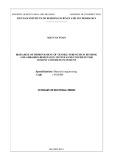
ISSN: 2615-9740
JOURNAL OF TECHNICAL EDUCATION SCIENCE
Ho Chi Minh City University of Technology and Education
Website: https://jte.edu.vn
Email: jte@hcmute.edu.vn
JTE, Volume 20, Issue 01, 02/2025
1
Effect of Materials on the Mechanical Properties of Fused Deposition Modeling
Three-Dimensional Printed Products
Duy Phu Nguyen2, Tu San Tran3, Hai Yen Tran1, Ngoc Phung Nguyen4, Thong Minh Vo1, Thi
Hong Nga Pham1, Vinh Tien Nguyen1, Thanh Tan Nguyen1*
1Ho Chi Minh City University of Technology and Education, Vietnam
2Thu Duc College Technology, Vietnam
3Dien Quang High Tech Company Limited, Vietnam
4Vintechpro Company Limited, Vietnam
*Corresponding author. Email: tannt@hcmute.edu.vn
ARTICLE INFO
ABSTRACT
Received:
18/09/2023
This study evaluates the three-dimensional (3D) printing materials used in
Fused Deposition Modeling (FDM) printing technology. 3D printing
technology has been developing strongly, becoming an effective support
tool in production and research. The 3D printing process involves many
stages, with many parameters affecting the quality and properties of the
product, in which 3D printing material is one of many essential factors
affecting that process. The study conducts a comprehensive assessment of
the most common materials in 3D printing technology to determine the
advantages and limitations of precisely five types of materials: Polylactic
acid, acrylonitrile butadiene styrene, polyethylene terephthalate glycol-
modified, thermoplastic polyurethane, and acrylonitrile styrene acrylate.
With 3D printing, parameters such as sintering temperature, printing speed,
and layer thickness are kept constant. These parameters are applied equally
to all five material samples. The experiment evaluates the tensile strength
of materials. The study results provide an overview of the properties and
applicability of 3D printing materials, helping to select materials suitable
for specific FDM 3D printing technology applications.
Revised:
29/12/2023
Accepted:
07/03/2024
Published:
28/02/2025
KEYWORDS
Fused Deposition Modeling;
3D printing materials;
Tensile strength;
Thermoplastic polyurethane;
Acrylonitrile styrene acrylate.
Doi: https://doi.org/10.54644/jte.2025.1464
Copyright © JTE. This is an open access article distributed under the terms and conditions of the Creative Commons Attribution-Non Commercial 4.0
International License which permits unrestricted use, distribution, and reproduction in any medium for on-commercial purpose, provided the original work is
properly cited.
1. Introduction
Three-dimensional (3D) printing technology was developed in the 1980s, and until now, 3D printing
is a popular method. Fused Deposition Modeling (FDM) technology is one of the 3D printing methods
that uses the force of extrusion of printed material into a molten filament form. The process of FDM 3D
printing technology is described in Figure 1 [1].
Figure 1. Process of FDM 3D printer















